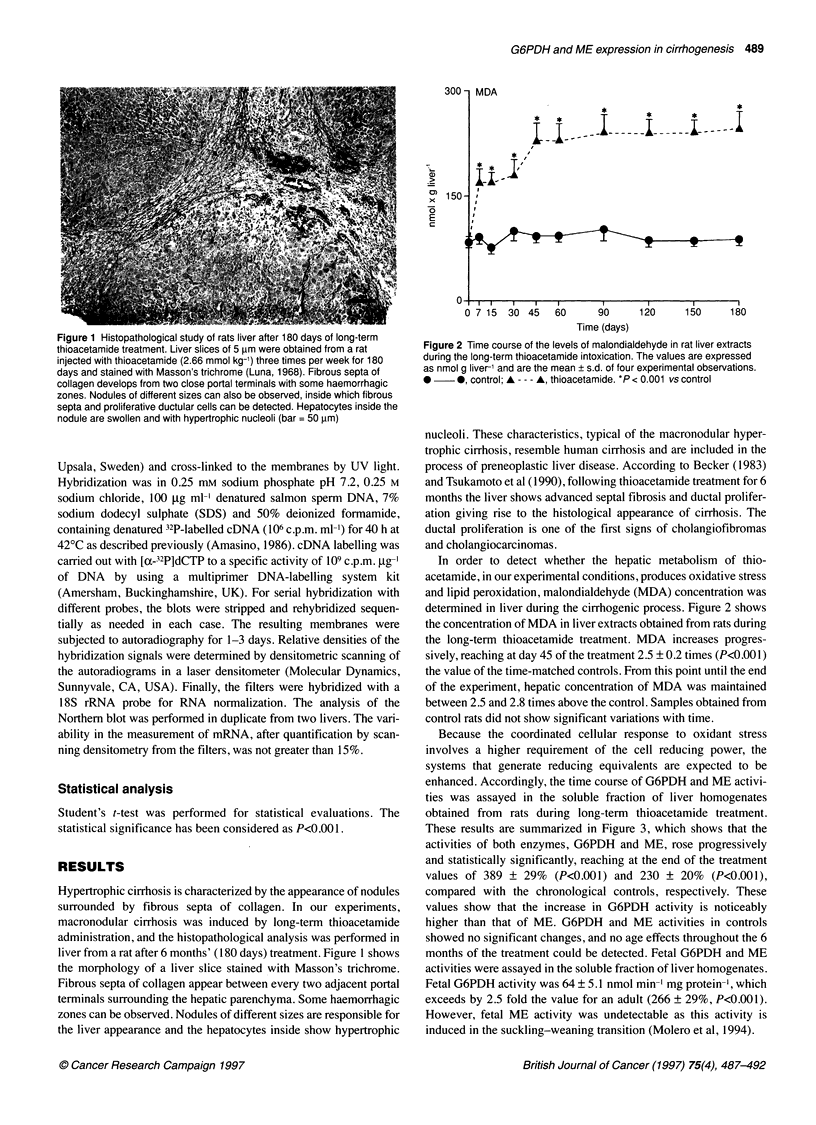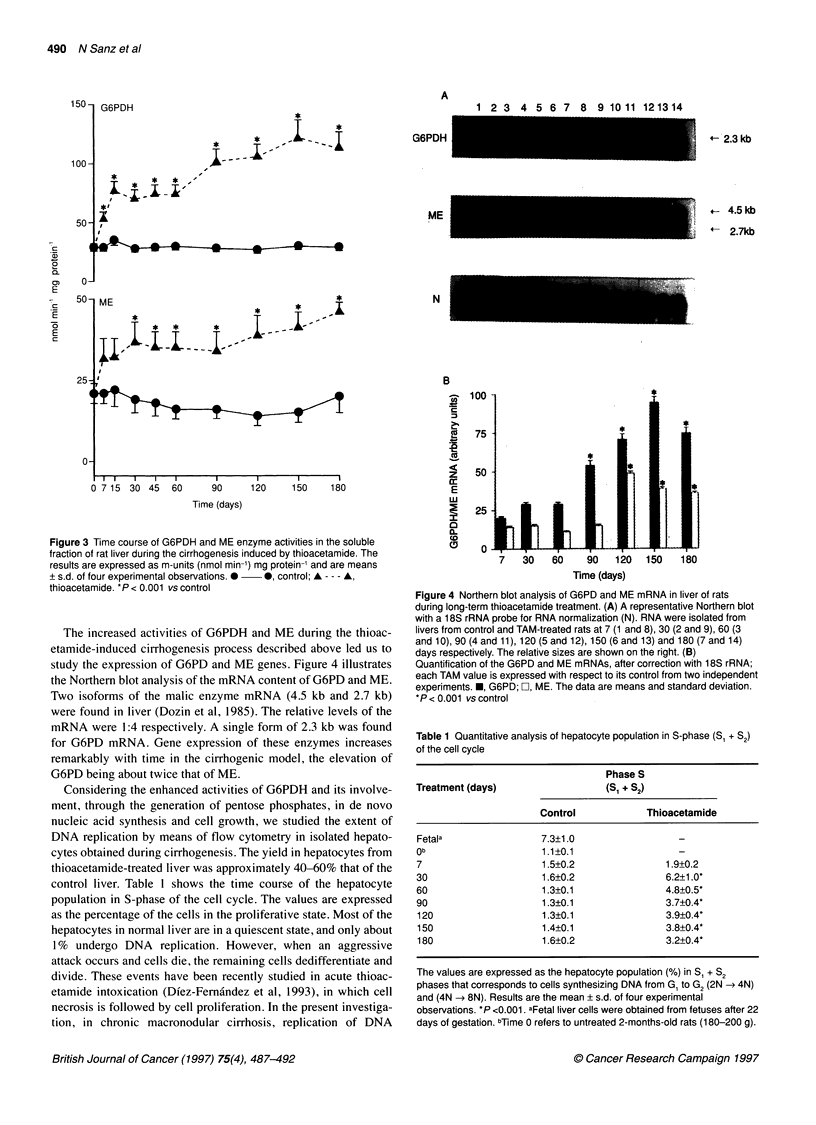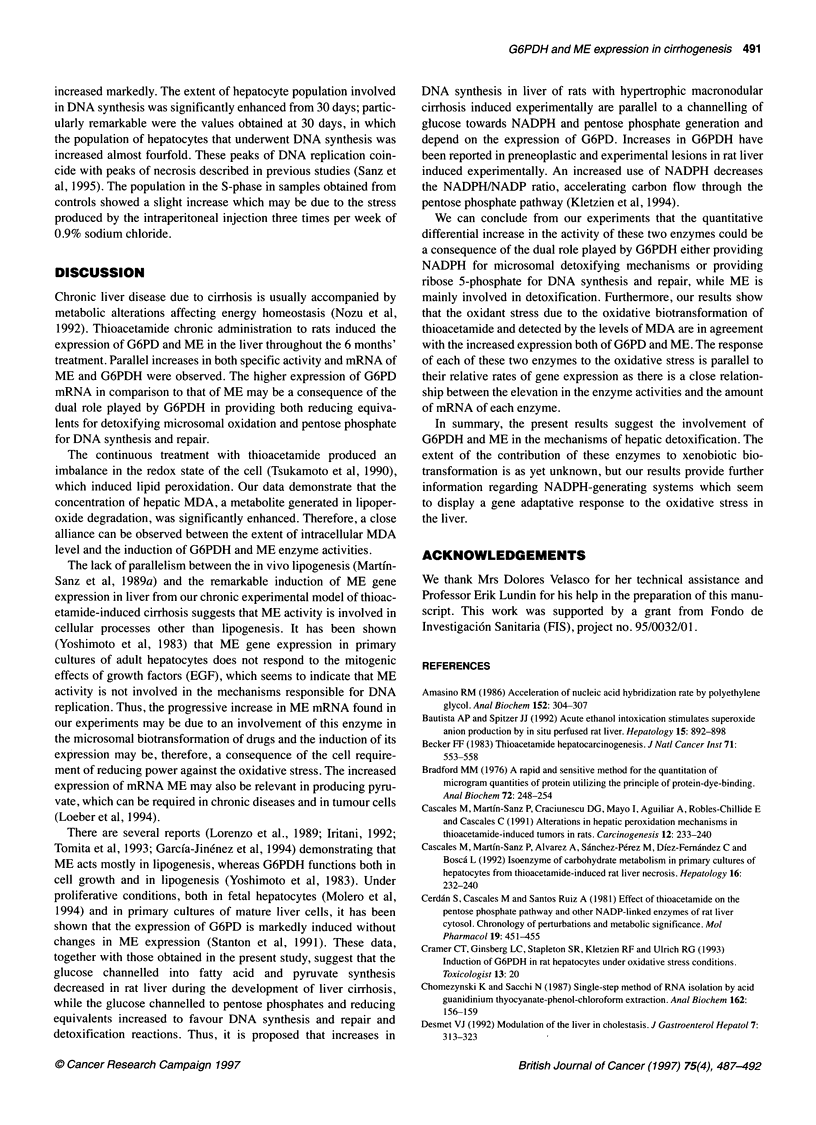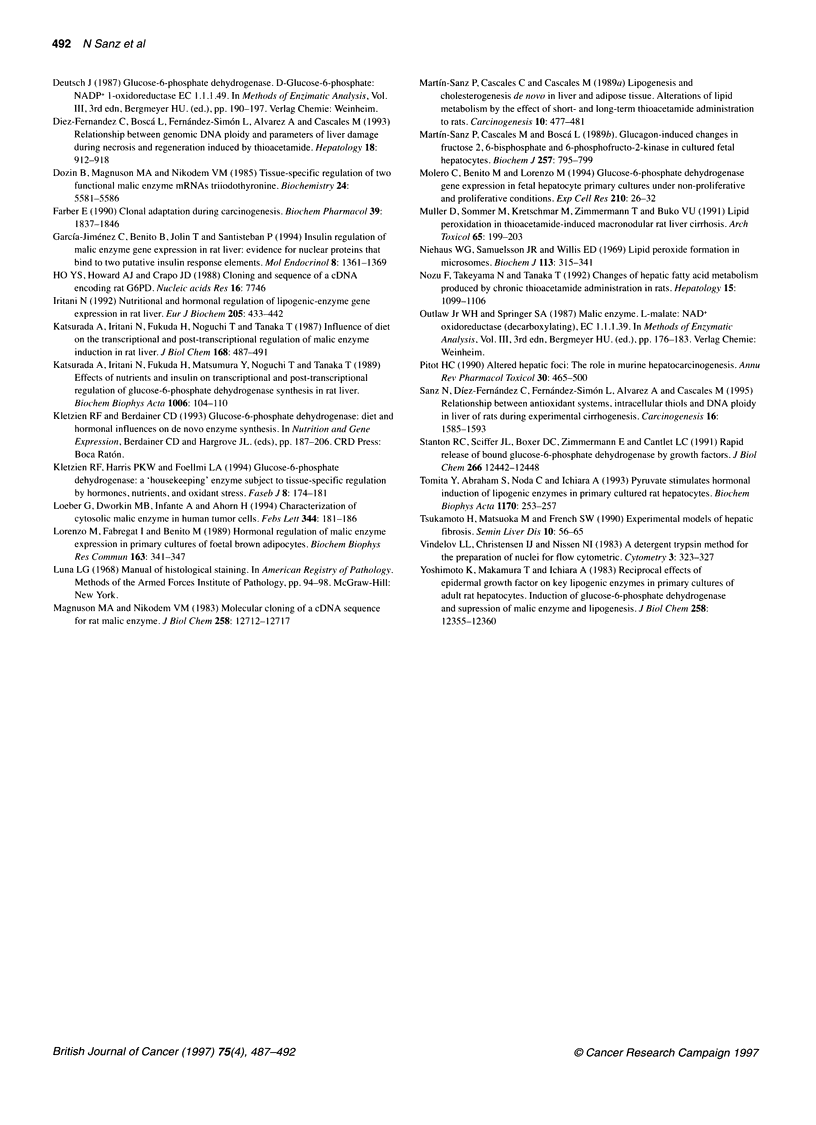Abstract
The cirrhogenic ability of thioacetamide has been used to induce a model of chronic generalized liver disease that resembles the preneoplastic state of human fibrosis. Malic enzyme (ME) and glucose-6-phosphate dehydrogenase (G6PDH) are two cytosolic NADPH-generating enzymes; their activities significantly increased in liver when macronodular cirrhosis was induced by long-term thioacetamide administration to rats. The progressive increase in G6PDH and ME activities during the cirrhogenic process is parallel to the induction in gene expression of both enzymes detected by the increase in their mRNAs. These data indicate that NADPH-consuming mechanisms such as the microsomal oxidizing system and the maintenance of the cell redox state could be involved. A relationship between the extent of G6PD and ME gene expression and oxidative stress generated by the oxidative metabolism of thioacetamide is proposed as the hepatic concentration of malondialdehyde, a metabolite derived from lipid peroxidation, underwent a progressive and significant enhancement during thioacetamide-induced cirrhogenesis. These results led us to suggest that the enhanced activities of G6PDH and ME might be related to microsomal mechanisms of detoxification as well as to the maintenance of the cellular redox state. Furthermore, the noticeable increase in the hepatocyte population involved in DNA replication parallel to G6PDH activity suggests that G6PDH, through ribose-5-phosphate, might also be involved in the processes of DNA synthesis and repair.
Full text
PDF





Images in this article
Selected References
These references are in PubMed. This may not be the complete list of references from this article.
- Amasino R. M. Acceleration of nucleic acid hybridization rate by polyethylene glycol. Anal Biochem. 1986 Feb 1;152(2):304–307. doi: 10.1016/0003-2697(86)90413-6. [DOI] [PubMed] [Google Scholar]
- Bautista A. P., Spitzer J. J. Acute ethanol intoxication stimulates superoxide anion production by in situ perfused rat liver. Hepatology. 1992 May;15(5):892–898. doi: 10.1002/hep.1840150523. [DOI] [PubMed] [Google Scholar]
- Becker F. F. Thioacetamide hepatocarcinogenesis. J Natl Cancer Inst. 1983 Sep;71(3):553–558. [PubMed] [Google Scholar]
- Bradford M. M. A rapid and sensitive method for the quantitation of microgram quantities of protein utilizing the principle of protein-dye binding. Anal Biochem. 1976 May 7;72:248–254. doi: 10.1006/abio.1976.9999. [DOI] [PubMed] [Google Scholar]
- Cascales M., Martin-Sanz P., Alvarez A., Sanchez-Pérez M., Diez Fernández C., Boscá L. Isoenzymes of carbohydrate metabolism in primary cultures of hepatocytes from thioacetamide-induced rat liver necrosis: responses to growth factors. Hepatology. 1992 Jul;16(1):232–240. doi: 10.1002/hep.1840160134. [DOI] [PubMed] [Google Scholar]
- Cascales M., Martín-Sanz P., Craciunescu D. G., Mayo I., Aguilar A., Robles-Chillida E. M., Cascales C. Alterations in hepatic peroxidation mechanisms in thioacetamide-induced tumors in rats. Effect of a rhodium(III) complex. Carcinogenesis. 1991 Feb;12(2):233–240. doi: 10.1093/carcin/12.2.233. [DOI] [PubMed] [Google Scholar]
- Cerdán S., Cascales M., Santos-Ruiz A. Effect of thioacetamide on the pentose phosphate pathway and other NADP-linked enzymes of rat liver cytosol: chronology of the perturbations and metabolic significance. Mol Pharmacol. 1981 May;19(3):451–455. [PubMed] [Google Scholar]
- Chomczynski P., Sacchi N. Single-step method of RNA isolation by acid guanidinium thiocyanate-phenol-chloroform extraction. Anal Biochem. 1987 Apr;162(1):156–159. doi: 10.1006/abio.1987.9999. [DOI] [PubMed] [Google Scholar]
- Desmet V. J. Modulation of the liver in cholestasis. J Gastroenterol Hepatol. 1992 May-Jun;7(3):313–323. doi: 10.1111/j.1440-1746.1992.tb00988.x. [DOI] [PubMed] [Google Scholar]
- Dozin B., Magnuson M. A., Nikodem V. M. Tissue-specific regulation of two functional malic enzyme mRNAs by triiodothyronine. Biochemistry. 1985 Sep 24;24(20):5581–5586. doi: 10.1021/bi00341a044. [DOI] [PubMed] [Google Scholar]
- Díez-Fernández C., Boscá L., Fernández-Simón L., Alvarez A., Cascales M. Relationship between genomic DNA ploidy and parameters of liver damage during necrosis and regeneration induced by thioacetamide. Hepatology. 1993 Oct;18(4):912–918. doi: 10.1002/hep.1840180424. [DOI] [PubMed] [Google Scholar]
- Farber E. Clonal adaptation during carcinogenesis. Biochem Pharmacol. 1990 Jun 15;39(12):1837–1846. doi: 10.1016/0006-2952(90)90599-g. [DOI] [PubMed] [Google Scholar]
- García-Jiménez C., Benito B., Jolin T., Santisteban P. Insulin regulation of malic enzyme gene expression in rat liver: evidence for nuclear proteins that bind to two putative insulin response elements. Mol Endocrinol. 1994 Oct;8(10):1361–1369. doi: 10.1210/mend.8.10.7854353. [DOI] [PubMed] [Google Scholar]
- Katsurada A., Iritani N., Fukuda H., Matsumura Y., Noguchi T., Tanaka T. Effects of nutrients and insulin on transcriptional and post-transcriptional regulation of glucose-6-phosphate dehydrogenase synthesis in rat liver. Biochim Biophys Acta. 1989 Nov 6;1006(1):104–110. doi: 10.1016/0005-2760(89)90329-9. [DOI] [PubMed] [Google Scholar]
- Katsurada A., Iritani N., Fukuda H., Noguchi T., Tanaka T. Influence of diet on the transcriptional and post-transcriptional regulation of malic enzyme induction in the rat liver. Eur J Biochem. 1987 Nov 2;168(3):487–491. doi: 10.1111/j.1432-1033.1987.tb13443.x. [DOI] [PubMed] [Google Scholar]
- Kletzien R. F., Harris P. K., Foellmi L. A. Glucose-6-phosphate dehydrogenase: a "housekeeping" enzyme subject to tissue-specific regulation by hormones, nutrients, and oxidant stress. FASEB J. 1994 Feb;8(2):174–181. doi: 10.1096/fasebj.8.2.8119488. [DOI] [PubMed] [Google Scholar]
- Loeber G., Dworkin M. B., Infante A., Ahorn H. Characterization of cytosolic malic enzyme in human tumor cells. FEBS Lett. 1994 May 16;344(2-3):181–186. doi: 10.1016/0014-5793(94)00386-6. [DOI] [PubMed] [Google Scholar]
- Lorenzo M., Fabregat I., Benito M. Hormonal regulation of malic enzyme expression in primary cultures of foetal brown adipocytes. Biochem Biophys Res Commun. 1989 Aug 30;163(1):341–347. doi: 10.1016/0006-291x(89)92141-4. [DOI] [PubMed] [Google Scholar]
- Magnuson M. A., Nikodem V. M. Molecular cloning of a cDNA sequence for rat malic enzyme. Direct evidence for induction in vivo of rat liver malic enzyme mRNA by thyroid hormone. J Biol Chem. 1983 Oct 25;258(20):12712–12717. [PubMed] [Google Scholar]
- Martín-Sanz P., Cascales C., Cascales M. Lipogenesis and cholesterogenesis de novo in liver and adipose tissue. Alterations of lipid metabolism by the effect of short- and long-term thioacetamide administration to rats. Carcinogenesis. 1989 Mar;10(3):477–481. doi: 10.1093/carcin/10.3.477. [DOI] [PubMed] [Google Scholar]
- Molero C., Benito M., Lorenzo M. Glucose-6-phosphate dehydrogenase gene expression in fetal hepatocyte primary cultures under nonproliferative and proliferative conditions. Exp Cell Res. 1994 Jan;210(1):26–32. doi: 10.1006/excr.1994.1004. [DOI] [PubMed] [Google Scholar]
- Nozu F., Takeyama N., Tanaka T. Changes of hepatic fatty acid metabolism produced by chronic thioacetamide administration in rats. Hepatology. 1992 Jun;15(6):1099–1106. doi: 10.1002/hep.1840150621. [DOI] [PubMed] [Google Scholar]
- Pitot H. C. Altered hepatic foci: their role in murine hepatocarcinogenesis. Annu Rev Pharmacol Toxicol. 1990;30:465–500. doi: 10.1146/annurev.pa.30.040190.002341. [DOI] [PubMed] [Google Scholar]
- Sanz N., Díez-Fernández C., Fernández-Simón L., Alvarez A., Cascales M. Relationship between antioxidant systems, intracellular thiols and DNA ploidy in liver of rats during experimental cirrhogenesis. Carcinogenesis. 1995 Jul;16(7):1585–1593. doi: 10.1093/carcin/16.7.1585. [DOI] [PubMed] [Google Scholar]
- Stanton R. C., Seifter J. L., Boxer D. C., Zimmerman E., Cantley L. C. Rapid release of bound glucose-6-phosphate dehydrogenase by growth factors. Correlation with increased enzymatic activity. J Biol Chem. 1991 Jul 5;266(19):12442–12448. [PubMed] [Google Scholar]
- Tomita Y., Abraham S., Noda C., Ichihara A. Pyruvate stimulates hormonal induction of lipogenic enzymes in primary cultured rat hepatocytes. Biochim Biophys Acta. 1993 Nov 3;1170(3):253–257. doi: 10.1016/0005-2760(93)90007-v. [DOI] [PubMed] [Google Scholar]
- Tsukamoto H., Matsuoka M., French S. W. Experimental models of hepatic fibrosis: a review. Semin Liver Dis. 1990 Feb;10(1):56–65. doi: 10.1055/s-2008-1040457. [DOI] [PubMed] [Google Scholar]
- Vindeløv L. L., Christensen I. J., Nissen N. I. A detergent-trypsin method for the preparation of nuclei for flow cytometric DNA analysis. Cytometry. 1983 Mar;3(5):323–327. doi: 10.1002/cyto.990030503. [DOI] [PubMed] [Google Scholar]
- Wills E. D. Lipid peroxide formation in microsomes. General considerations. Biochem J. 1969 Jun;113(2):315–324. doi: 10.1042/bj1130315. [DOI] [PMC free article] [PubMed] [Google Scholar]
- Yoshimoto K., Nakamura T., Ichihara A. Reciprocal effects of epidermal growth factor on key lipogenic enzymes in primary cultures of adult rat hepatocytes. Induction of glucose-6-phosphate dehydrogenase and suppression of malic enzyme and lipogenesis. J Biol Chem. 1983 Oct 25;258(20):12355–12360. [PubMed] [Google Scholar]




